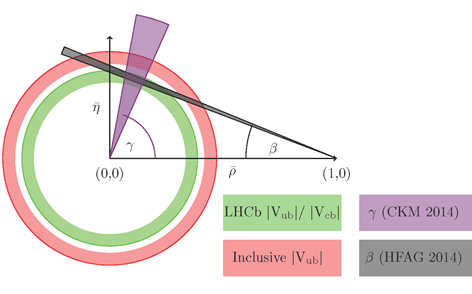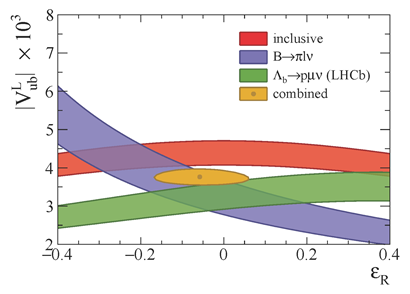The LHCb collaboration published today in Nature Physics a paper based on run 1 data which reports the determination of the parameter |Vub| describing the transition of a b quark to a u quark. This measurement was made by studying a particular decay of the Λb0 baryon. Other measurements of |Vub| by previous experiments had returned two sets of inconsistent results, depending on which method was used to determine the parameter. Theorists had suggested that this discrepancy could be explained by the presence a new particle contributing to the decay process, which affected the result differently, depending on the measurement method. Today’s result from LHCb removes the need for this new particle, while the puzzle of why the original sets of measurements do not agree persists.
The Λb0 baryon is like a proton, but containing a beauty (b) quark in place of one of the up (u) quarks such then when the b quark decays into an u quark it transforms the Λb0 into a proton. A W boson is emitted in this process and decays in turn into a muon μ and a neutrino νμ. The measurement of decays involving a neutrino is very challenging at a proton collider and it was quite a surprise that this measurement could be done. The probability of the Λb0→pμνμ decay depends on the SM parameter |Vub|. The image shows two simultaneous proton-proton collisions inside the LHCb detector shown by the pink ellipses. The Λb0 baryon is produced in the right hand side collision and travels a distance of about 1 cm until it decays into a proton (orange), a muon (pink) and an invisible neutrino.
The |Vub| is a parameter of the 3×3 Cabibbo-Kobayashi-Maskawa (CKM) matrix. In the SM the CKM matrix describes the decay of one quark to another by the emission of a W boson. While the SM does not predict the values of the parameters of the CKM matrix, the measurements of these parameters in different processes should be consistent with each other. If they are not, it is a sign of physics beyond the SM. The consistency is visualized with a help of so called “unitarity triangle”. The LHCb |Vub| result determines a length of the triangle side opposite to the angle β in the left image below, which together with the measurement of the angle γ gives a consistent SM description. On the other hand, the |Vub| result marked “Inclusive” does not, as will be discussed below.
The Λb0→pμνμ decay belongs to a class of so called “exclusive” measurements meaning that a specific (exclusive) decay is used. The Babar and Belle collaborations have in addition measured the decay rate in an “inclusive” way by summing over all possible B meson decays containing the b to u quark transition. Their results from exclusive and inclusive measurements showed a large difference. This could be explained by a new particle, in addition to the W boson, contributing to the quark transition. (For experts: if this new particle had a right-handed coupling, as opposed to the W boson that only interact with left-handed quarks, the inclusive and exclusive results could be made to agree.) In the right figure above, the crossing of the purple and the red band at about -0.2 on the εR x-axis shows that the new particle would have to have a strength of about 20% with respect to the W boson for the quark transition. The measurement from LHCb using a Λb0 decay gives a different dependence of the transition probability from a new particle as marked with the green band. This is due to the different spin of the Λb0 baryon compared to the B mesons used previously. That the crossing of the purple band with the green band is exactly at zero removes the need for a new particle. However, it still leaves the puzzle as to why the inclusive and exclusive measurements do not agree. Further intensive research, both at the experimental and theoretical level, will continue to try to understand this disagreement.
Click the images for higher resolution. Read more in the LHCb publication and in Nature Physics News & Views.



